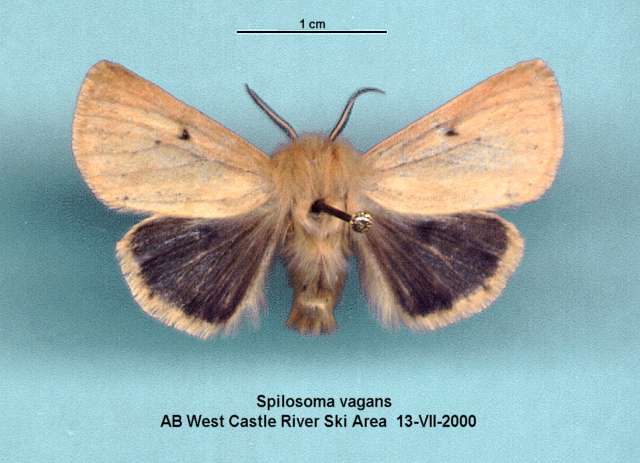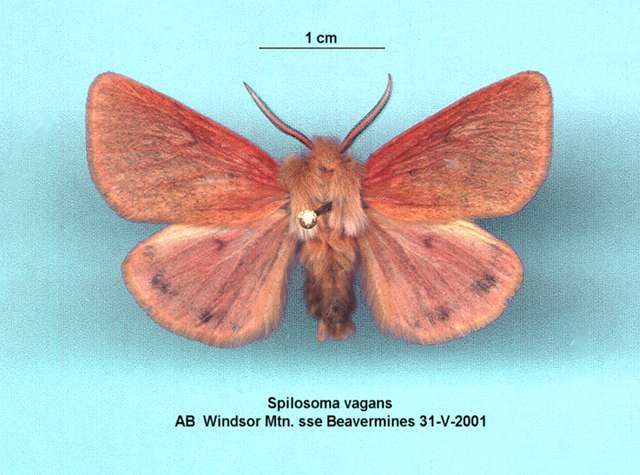Species Details
Spilosoma vagans
University of Alberta E.H. Strickland Entomological Museum Read more about this collection »
Common NameWandering Tiger
SeasonalityJune.
IdentificationThis species is extremely variable, which can lead to some confusion. The wing colouration varies with respect to both ground colour (reddish brown to light ochre) and the extent of the dark markings; the forewing may have no dark markings or exhibit faint bands, and the hindwing can vary from entirely brown-grey (except for the fringe) to reduced,dark submarginal and discal spots. However, other Spilosoma are predominantly white; S. pteridis is brown, and markedly smaller.
Scientific Name
Spilosoma vagans
Common Name
Wandering Tiger
Habitat
Open montane meadows and woodlands.
Seasonality
June.
Identification
This species is extremely variable, which can lead to some confusion. The wing colouration varies with respect to both ground colour (reddish brown to light ochre) and the extent of the dark markings; the forewing may…
This species is extremely variable, which can lead to some confusion. The wing colouration varies with respect to both ground colour (reddish brown to light ochre) and the extent of the dark markings; the forewing may have no dark markings or exhibit faint bands, and the hindwing can vary from entirely brown-grey (except for the fringe) to reduced,dark submarginal and discal spots. However, other Spilosoma are predominantly white; S. pteridis is brown, and markedly smaller.
Life History
No information available.
Diet Info
Unknown. Probably herbaceous plants.
Range
Southern B.C. and southwestern Alberta south to California and Colorado. The only known Alberta populations occur in the Waterton-Crowsnest area, with one record from Lethbridge.
References
Author
Schmidt, B. C.
Title
The tiger moths (Arctiidae) of Alberta.
Publication Date
2000
Pages
36
Specimen Information
There are 59 specimens of this Species.
UASM172071 - Spilosoma vagans
University of Alberta E.H. Strickland Entomological Museum
Place CollectedCanada: Alberta, Waterton Lakes National Park, Chief Mountain
Collected ByRoe; Lumley; Schmidt
Date Collected2005-07-08
UASM172072 - Spilosoma vagans
University of Alberta E.H. Strickland Entomological Museum
Place CollectedCanada: Alberta, Hillcrest
Collected ByBowman, K.
Date Collected1921-06-25
UASM172073 - Spilosoma vagans
University of Alberta E.H. Strickland Entomological Museum
Place CollectedCanada: Alberta, Hillcrest
Collected ByBowman, K.
Date Collected1921-06-26
UASM172074 - Spilosoma vagans
University of Alberta E.H. Strickland Entomological Museum
Place CollectedCanada: Alberta, Hillcrest
Collected ByBowman, K.
Date Collected1922-06-25
UASM172075 - Spilosoma vagans
University of Alberta E.H. Strickland Entomological Museum
Place CollectedCanada: Alberta, Hillcrest
Collected ByBowman, K.
Date Collected1922-06-25
UASM172076 - Spilosoma vagans
University of Alberta E.H. Strickland Entomological Museum
Place CollectedCanada: Alberta, Hillcrest
Collected ByBowman, K.
Date Collected1922-06-25
UASM172077 - Spilosoma vagans
University of Alberta E.H. Strickland Entomological Museum
Place CollectedCanada: Alberta, Hillcrest
Collected ByBowman, K.
Date Collected1922-06-25
UASM172078 - Spilosoma vagans
University of Alberta E.H. Strickland Entomological Museum
Place CollectedUnited States: Oregon, Jackson county, Mount Ashland
Collected ByTroubridge, J.
Date Collected1998-08-02
UASM172079 - Spilosoma vagans
University of Alberta E.H. Strickland Entomological Museum
Place CollectedUnited States: Oregon, Jackson county, Mount Ashland
Collected ByTroubridge, J.
Date Collected1998-08-02
UASM172080 - Spilosoma vagans
University of Alberta E.H. Strickland Entomological Museum
Place CollectedUnited States: Oregon, Jackson county, Mount Ashland
Collected ByTroubridge, J.
Date Collected1998-08-02
UASM172081 - Spilosoma vagans
University of Alberta E.H. Strickland Entomological Museum
Place CollectedUnited States: California, Plumas county, Jackson Creek
Collected ByTroubridge, J.
Date Collected1999-06-14
UASM172082 - Spilosoma vagans
University of Alberta E.H. Strickland Entomological Museum
Place CollectedUnited States: California, Plumas county, Jackson Creek
Collected ByTroubridge, J.
Date Collected1999-06-14
UASM172083 - Spilosoma vagans
University of Alberta E.H. Strickland Entomological Museum
Place CollectedUnited States: California, Plumas county, Jackson Creek
Collected ByTroubridge, J.
Date Collected1999-06-14
UASM172084 - Spilosoma vagans
University of Alberta E.H. Strickland Entomological Museum
Place CollectedCanada: British Columbia, Okanagan Falls
Collected ByTroubridge; Gardiner
Date Collected1992-03-23/1992-03-31
UASM172085 - Spilosoma vagans
University of Alberta E.H. Strickland Entomological Museum
Place CollectedCanada: British Columbia, Okanagan Falls
Collected ByTroubridge; Gardiner
Date Collected1992-03-23/1992-03-31
UASM172086 - Spilosoma vagans
University of Alberta E.H. Strickland Entomological Museum
Place CollectedCanada: British Columbia, Okanagan Falls
Collected ByTroubridge, J.
Date Collected1992-03-22/1992-03-28
UASM172087 - Spilosoma vagans
University of Alberta E.H. Strickland Entomological Museum
Place CollectedCanada: British Columbia, Okanagan Falls
Collected ByTroubridge; Gardiner
Date Collected1992-05-10/1992-05-16



